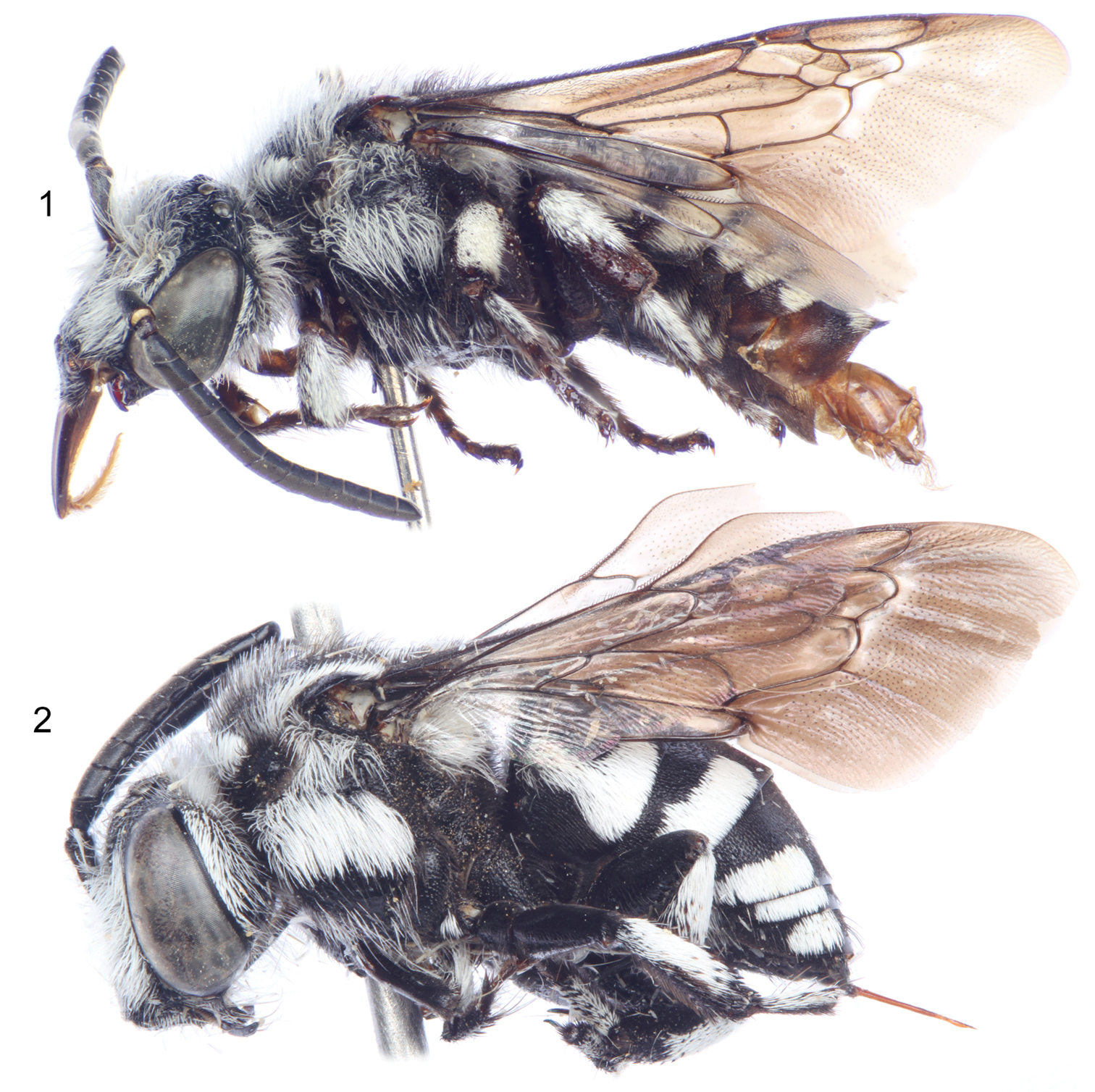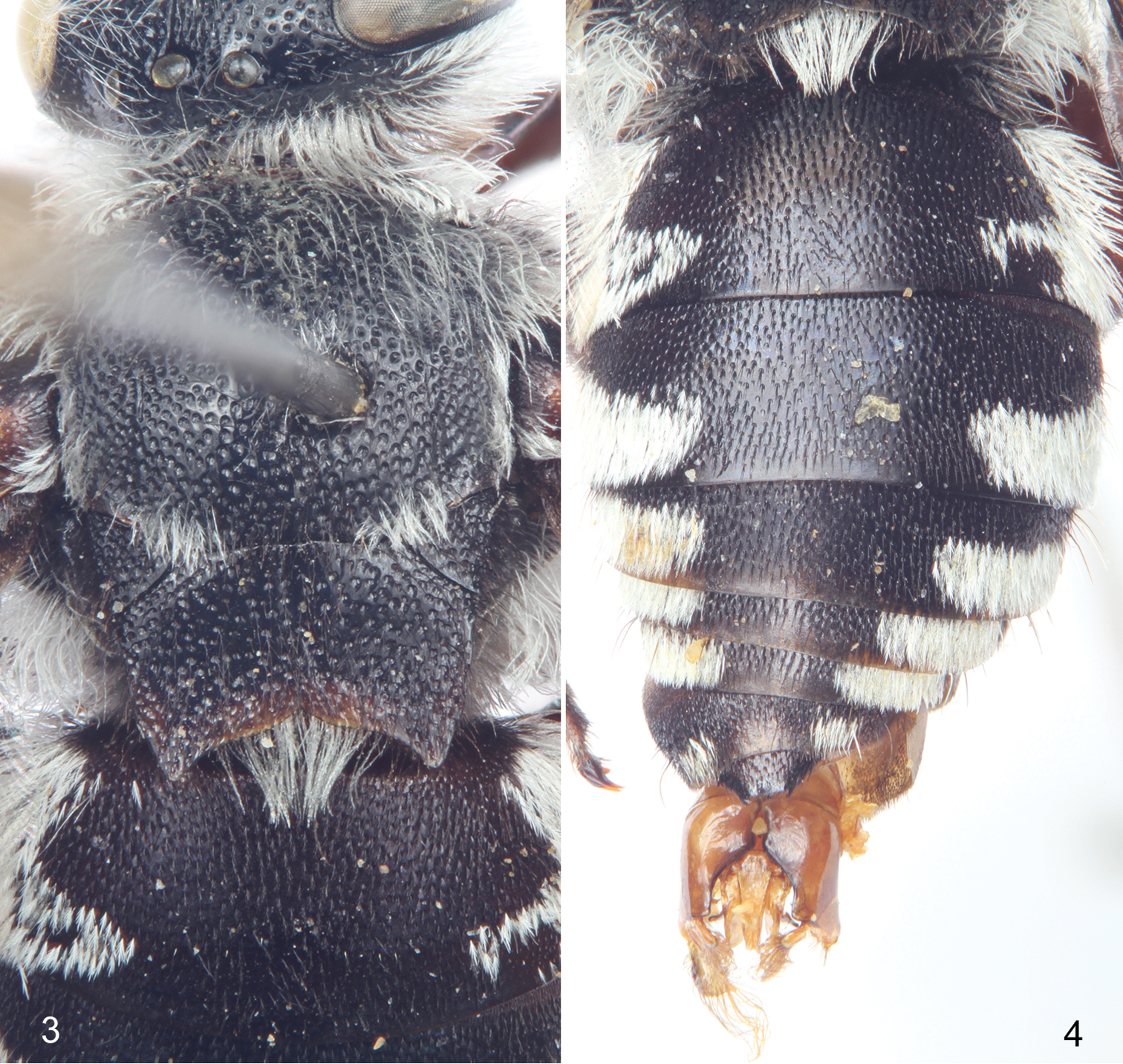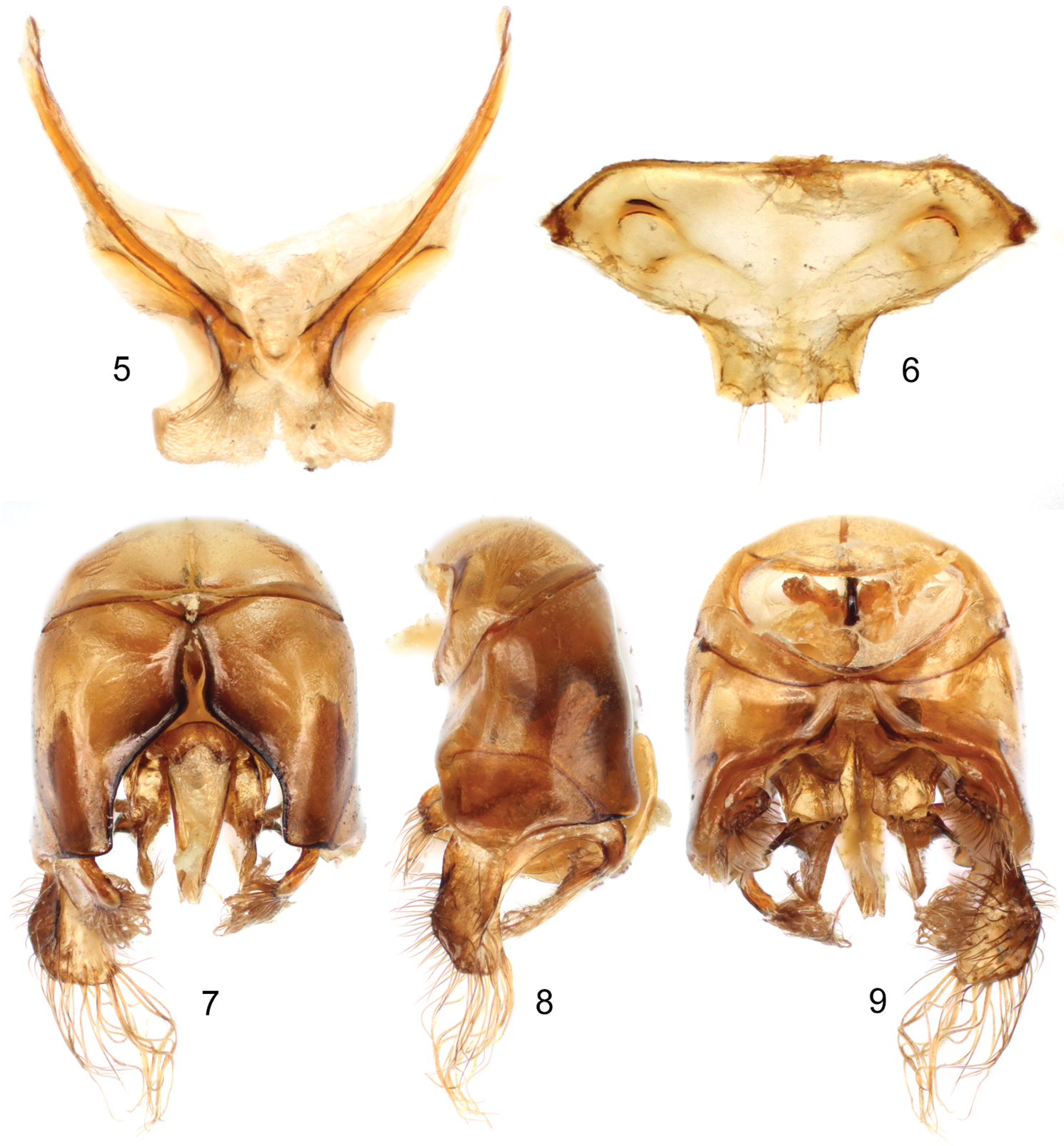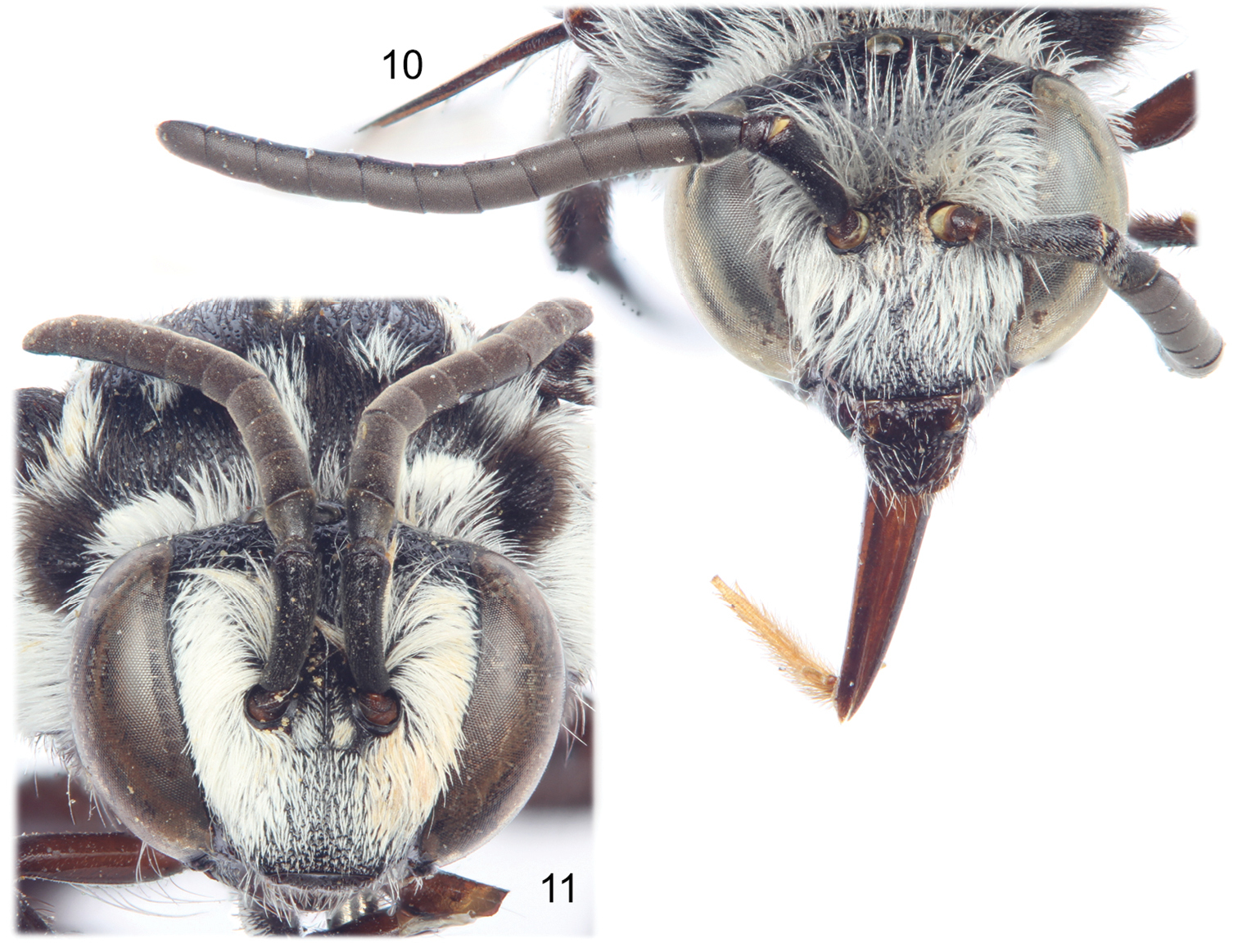






Citation: Alqarni AS, Hannan MA, Engel MS (2014) A new species of the cleptoparasitic bee genus Thyreus from northern Yemen and southwestern Saudi Arabia (Hymenoptera, Apidae). ZooKeys 428: 29–40. doi: 10.3897/zookeys.428.7821
A new species of cleptoparasitic bee of the genus Thyreus Panzer (Apinae: Melectini) is described and figured from northern Yemen and southwestern Saudi Arabia. Thyreus shebicus Engel, sp. n. is a relatively small species superficially similar to the widespread and polytypic species T. ramosus (Lepeletier de Saint Fargeau) and T. ramosellus (Cockerell) but more closely allied to various African forms on the basis of the male genitalia. The species is distinguished from its congeners on the basis of coloration pattern, male hind leg structure, and particularly male terminalia.
Apoidea, Anthophila, Melectini, Arabian Peninsula, taxonomy, cleptoparasitism
The cleptoparasitic bee genus Thyreus Panzer is one of the more remarkable of Old World lineages. The genus consists of 108 described species (
During ongoing survey work in the Kingdom of Saudi Arabia (e.g.,
Lateral habitus of Thyreus shebicus Engel, sp. n. 1 Male (holotype) 2 Female (paratype).
Material is deposited in the King Saud University Museum of Arthropods, Plant Protection Department, College of Food and Agriculture Sciences, King Saud University, Riyadh, Kingdom of Saudi Arabia (KSMA) and Division of Entomology (Snow Entomological Collections), University of Kansas Natural History Museum, Lawrence, Kansas, USA (SEMC). Morphological terminology is based on that of
♂, N. Yemen, high plateau, 14-4-82 [14 April 1982], I.L. Hamer (SEMC). This is the exact label data from the holotype male and is unfortunately not very precise but likely refers to the mountainous area north of Sana’a and bordering Jazan, Saudi Arabia.
1♀, Saudi Arabia, Asir, Abha, Sawdah [Sodah] (near ropeway), 2670 m, 18°17'37.19"N, 42°21'31.49"E, 22-v-2012 [22 May 2012], M.A. Hannan (KSMA); 1♀, Saudi Arabia: Asir, Abha, Sodah, nr. dam, 2500 m, 18°14'11.64"N, 42°24'49.96"E, 22-v-2012 [22 May 2012], M.S. Engel (SEMC); 1♀, Saudi Arabia, Abha, 6.vi.1972 [6 June 1972], 18.13°42.30°E, A.W. Harvey (SEMC).
The new species is superficially similar to Thyreus ramosus and Thyreus ramosellus (Cockerell) but can be distinguished most readily in the form of the male terminalia [cf. Figs 5–9 with those in
♂: Total body length 10.0 mm; forewing length 7.5 mm. Head wider than long (length 2.3 mm, width 2.9 mm); upper interorbital distance 1.8 mm; lower interorbital distance 1.3 mm. Intertegular distance 2.2 mm; mesoscutellar posterior margin with median emargination, weakly sinuate (Fig. 3), apicolateral angle only weakly produced. Ventral longitudinal carina of metafemur incomplete, carinate only in apical two-thirds, basad carina becomes a defined acarinate angled ridge (in this regard somewhat similar to Thyreus ramosellus); inner anterior angle of metatibia not swollen or projecting into prominence or point between metatibial spurs but inner apical border bearing spurs produced gradually outward and posteriorly bordered by apical depressed area with more elongate black setae; apex of metatibia without comb of dense, long, fine, plumose setae; outer surface of metabasitarsus not concave. Apex of seventh metasomal tergum with apicolateral prominences distinct, acutely pointed, length of individual prominence less than one-half of distance between them, truncate margin between prominences straight, without medial emargination or swelling; male terminalia as in Figs 5–9.
Male (holotype) of Thyreus shebicus Engel, sp. n. 3 Mesosomal dorsum 4 Metasomal dorsum.
Male terminalia of holotype of Thyreus shebicus Engel, sp. n. 5 Seventh metasomal sternum 6 Eighth metasomal sternum 7 Genital capsule, dorsal view 8 Genital capsule, lateral view 9 Genital capsule, ventral view. Note: One gonostylus is missing.
Labrum with coarse punctures separated by less than a puncture width except medially and basally separated by a puncture width or slightly less and small, circular, basolateral impunctate areas, integument between punctures smooth, basomedially with shallow, short V-shaped furrow with smaller closer punctures therein; clypeus with small nearly contiguous punctures, integument between smooth; supraclypeal area as on clypeus except punctures sparse medially; lower face as on clypeus except punctures more well defined, becoming progressively larger toward upper frons; punctures become smaller and sparser in ocellocular area, integument between punctures smooth; punctures weaker and shallower on vertex, separated by less than a puncture width immediately posterior to ocelli and bordering preoccipital carina, otherwise rather sparse on vertex; punctures of gena coarse, shallow, and progressively more dense from above to nearly contiguous by midlength; postgena finely imbricate and impunctate. Pronotum with coarse, shallow punctures separated by a puncture width or less, integument between smooth to faintly imbricate; mesoscutum with well-defined, coarse, contiguous punctures laterally (Fig. 3), punctures slightly more widely spaced medially such that punctures separated by about 0.25–0.5 times a puncture width, integument between punctures smooth; axilla with punctures contiguous; mesoscutellum with punctures as on mesoscutum except separated by 0.25–0.75 times a puncture width, more closely spaced laterally; pleura with coarse, nearly contiguous punctures, integument between punctures (where evident) finely and faintly imbricate, punctures of mesopleuron ventrally becoming more elongate and widely spaced, punctures of preëpisternal area and metapleuron smaller than those of mesopleuron and contiguous; hypoepimeral area large, coarse, nearly contiguous punctures; propodeal lateral and posterior surfaces with coarse, shallow, ill-defined, nearly contiguous punctures. Metasoma with small punctures separated by a puncture width or more often less (Fig. 4), punctures more coarse, larger, and somewhat more poorly defined on discs of more apical terga, integument between faintly and finely imbricate, apical margins narrowly impunctate and finely imbricate; sterna with similar punctation except those on discs of more basal sterna more widely spaced and becoming more poorly defined on more apical sterna.
Integument black except dark brown on labrum, mouthparts, legs, and apically on mesoscutellum, seventh metasomal tergum, and on apical sterna. Wing membranes hyaline and slightly infumate except with whitish along apical border of 2rs-m and 2m-cu (Figs 1–2), veins dark brown to black.
Pubescence generally fuscous to black over entire body except in the presence of long plumose white setae over most of face (Fig. 10), posterior on vertex, ventral margin of mandible, entire gena, postgena, outer surface of protibia and probasitarsus (although white setae appressed and short on this surface), outer surface of mesotibia and mesotarsus (appressed on these surfaces), apical ventro-posterior border of mesofemur, outer posterior angles of meso- and metacoxae, outer surface of metatibia and metarasus (appressed on these surfaces), and on mesosoma (using the annotation system of
Faces of Thyreus shebicus Engel, sp. n. 10 Male (holotype) 11 Female (paratype).
♀: As described for male except in usual gender differences and as follows: Total body length 8.1–9.9 mm; forewing length 7.1–8.1 mm. Head wider than long (length 2.3–2.6 mm, width 2.9–3.4 mm); upper interorbital distance 1.8–1.9 mm; lower interorbital distance 1.3–1.5 mm. Intertegular distance 2.3–2.7 mm; mesoscutellar posterior margin as in male but sometimes sinuate margin weaker and posterior angles more prominent. Pygidial plate relatively narrow, lateral margins largely straight and converging apically, apex broad and truncate, surface imbricate and impunctate, apically with weak medial carina.
Mesoscutal punctures slightly more spaced than in male; metasomal terga with punctures generally separated by less than a puncture width, apical margins narrowly impunctate and imbricate except apical margin of fifth tergum broadly impunctate and imbricate, covering approximately apical half.
Integument and pubescence as in male except reddish brown on pygidial plate; white mesoscutal setal patches generally more well defined and not as diffuse as in male; second through fifth metasomal terga with transverse lateral patches (Fig. 2).
The specific epithet refers to the ancient kingdom of Sheba, realm of the Queen of Sheba and the people of Tubba’, and likely consanguineous with the Sabaeans who occupied several of those areas in the southwest of the Arabian Peninsula in which the species here has been taken.
At first glance the new species could easily be confused with the widespread Thyreus ramosus and, despite some of the difficulties with
Admittedly, Thyreus is not only a large and diverse group, encompassing a vast distribution throughout the Old World, but the distinctions between natural units have been challenging to discern. Lieftinck’s herculean effort was certainly a massive leap forward and some of his hypotheses for widespread and rather polytypic species require further testing, ideally in combination with genetic data. In addition to the aforementioned Thyreus ramosus and Thyreus ramosellus, another such suspicious species is Thyreus nitidulus (Fabricius) (vide
Several suitable species of Amegilla were found flying in the same locality as Thyreus shebicus. Any or multiples of these may serve as the host for this species and only through discovery of the nests of the Amegilla will it be possible to ascertain the specific association of the cleptoparasite. Continued intensive sampling and hunting for nests of bees in southwestern Saudi Arabia and particularly in the area around Abha is needed. Presently documented species of Thyreus from the Arabian Peninsula include the regionally widespread Thyreus elegans (Morawitz) and Thyreus ramosus, Thyreus ramosellus in the northern parts, Thyreus parthenope Lieftinck in largely the west and south of the peninsula (western Saudi Arabia and Yemen), and Thyreus fallibilis (Kohl) in the southwest [originally described from ‘South Arabia’, a former name for the Republic of Yemen and some parts of Jazan, Asir, and Najran (N.B.: ‘S. Arabia’ on many pre-1968 labels refers to ‘South Arabia’, of the Federation of South Arabia or the Protectorate of South Arabia, and not Saudi Arabia)].
We are grateful to the Visiting Professor Program at King Saud University for its funding of this research. In addition, we are thankful to Claus Rasmussen and Jakub Straka who, acting as official reviewers, provided constructive feedback for the improvement of the manuscript. This is a contribution of the Department of Plant Protection, College of Food and Agriculture Sciences, King Saud University and the Division of Entomology, University of Kansas Natural History Museum.



